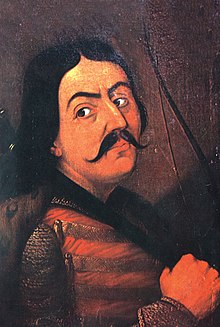Dragoș, Voivode of Moldavia

Dragoş was a Maramureş Voivode ruling over the lands of what was to become Moldavia (between 1351 and 1353). He left Maramureş by orders from the Hungarian King Louis I, in order to establish a defense line against the Golden Horde. The campaign forced the Mongols to retreat east of the Dniester. He was succeeded by his son, Sas (ruled 1354-1358). Sas was then succeeded by his own son, Bâlc in 1359, but managed to rule the country for only one year before being disposed by another Romanian voevode from Maramureş, Bogdan. The direct bloodline of Dragoş in the Moldavian rulership ended there. Dragoş is a very popular Romanian first name, although it can also be a last name, and is pronounced Dragosh.
Legends
A Romanian legend recounts Dragoş' founding of Moldavia as the result of an aurochs hunt, during which Molda, a hound bitch of his, was mortally wounded. In remembrance of his pet, Dragoş named the river Moldova - the name was to be extended to the country itself at a latter date. This version is present in the works of Wallachian chronicler Radu Popescu and the Moldavian Prince Dimitrie Cantemir (namely, his Descriptio Moldaviae). The Moldavian coat of arms, which depicts an aurochs, relates to this legend.
Other records of the legend hold certain differences: while some indicate that Dragoş hunted alone, Grigore Ureche's account (which is also the most detailed) says that "Dragoş of Cuhea" (in Maramureş), a man "of royal origins" was accompanied by 300 men who would later be the founders of the village of Boureni (from bour, meaning "aurochs"), the first village in the Principality.
The accuracy of the founding (descălecat - literally, "dismounting") story has been disputed ever since the early 1700s (Cantemir). In the late 1800s, Dimitrie Onciul argued that the "descălecat" was a myth attempting to explain the origin of aurochs depicted in the Moldavian coat-of-arms (as present today in Romanian and Moldovan heraldry).
Legacy
- Legend has Dragoş as the founder of the city of Vatra Dornei, named in memory of a beautiful shepherdess whom he would have met there.
- A wooden church at Putna (33km of Rădăuţi) was raised by Dragoş in 1346; it was restored in 1468.